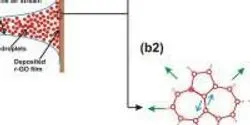News

A simple, inexpensive spray method that deposits a graphene film can heal manufacturing defects and produce a high-quality graphene layer on a range of substrates, report researchers at the University of Illinois at Chicago and Korea University.

Ferroelectric materials–substances in which there is a slight and reversible shift of positive and negative charges–have surfaces that are coated with electrical charges like roads covered in snow. Accumulations can obscure lane markings, making everyone unsure which direction traffic ought to flow; in the case of ferroelectrics, these accumulations are other charges that “screen” the true polarization of different regions of the material.

Dr. Zhaozheng Yin, an assistant professor of computer science at Missouri University of Science and Technology, recently received the National Science Foundation’s most prestigious award for young faculty members for his research into developing algorithms and systems for processing microscopy images of biological specimens.

New research by an international consortium, including a researcher from Lawrence Livermore National Laboratory, may help physicians better understand the chronological development of a brain aneurysm.

Maintaining astronaut bone and muscle health in microgravity is an ongoing concern for NASA, and now the agency is “forcing” the issue with a new investigation.

A team of researchers from the National University of Singapore’s (NUS) Faculty of Engineering has developed a cost-effective solution for the control of indoor air pollution, especially from the haze. The development of this system is timely in light of the World Health Organization’s (WHO) recent news on the risks of inhalation of particulate matter measuring less than 2.5 microns (PM2.5), which has been linked to a range of cardiovascular and respiratory ailments, including cancer. The new system is easy to use and ideal for use in a range of indoor environments.

In the wake of recent off-shore oil spills, and with the growing popularity of “fracking” — in which water is used to release oil and gas from shale — there’s a need for easy, quick ways to separate oil and water. Now, scientists have developed coatings that can do just that. Their report on the materials, which also could stop surfaces from getting foggy and dirty, appears in the American Chemical Society's ACS Applied Materials & Interfaces.













